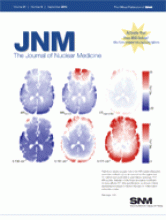The prevalence of diabetes is dramatically high, and the acquired type II form is particularly expected to further increase considerably (from 6.6% of the world population [285 million people] in 2010 to 7.8% [439 million people] in 2030) (1). Diabetes is caused by a disrupted secretion of insulin and a subsequent increase in plasma glucose levels. Insulin is produced by the β-cells of the 1–2 million islets of Langerhans in a pancreas. These islets represent only about 2%–3% of the pancreas cell mass, which consists mostly of exocrine tissue. Autopsy studies have shown that the relative β-cell volume is reduced by more than 50% in diabetic subjects, See page 1439
and animal models in which more than 50% of the β-cell volume had been destroyed have shown impaired glucose homeostasis (2).
Thus, an important tool for diabetes research would be noninvasive in vivo quantification of β-cell mass, particularly longitudinal quantification for monitoring new antidiabetic therapies. Research on imaging of β-cell mass has focused on various techniques (PET, SPECT, MRI, optical imaging) using, among others, peptides, antibodies, manganese, annexin derivatives, sulfonylureas, and 6-fluoro-l-dopa (3,4). The challenge of imaging β-cell mass is the small dimensions (∼0.1-mm diameter) of the islets of Langerhans, combined with the relatively small fraction of β-cells (∼2%) in the pancreas, requiring that tracers or contrast agents have a high selectivity for β-cells versus exocrine tissue.
A study that mapped gene expression showed that the vesicular monoamine transporter 2 (VMAT2) is expressed by β-cells but not by exocrine pancreatic cells (5). 11C-dihydrotetrabenazine, a PET tracer that had been developed to visualize VMAT2 in the brain (6), was applied in PET studies of diabetes and showed less pancreatic uptake in diabetic rats than in control rats (5) and a longitudinal decrease in the pancreatic standardized uptake value (≤65%) of spontaneous diabetic rats (7). Encouraged by these results, researchers have synthesized and are evaluating several 18F derivatives of dihydrotetrabenazine (8,9).
The preclinical results were partially confirmed in clinical studies that showed lower 11C-dihydrotetrabenazine binding potentials in type 1 diabetic patients than in control subjects. Patients with longstanding type 1 diabetes are, however, expected to have a near-total loss of β-cell mass, whereas the observed 11C-dihydrotetrabenazine binding potential was still 86% of the value in control subjects (10). It was hypothesized that the discrepancy between preclinical and clinical studies was caused by modeling artifacts introduced by using the kidney as a reference tissue, by the use of VMAT2 expression in other cell types of the pancreas, and by species differences in tracer kinetics or radiometabolite accumulation.
Using ex vivo autoradiography and in vitro tissue-binding competition studies, Fagerholm et al. now show in this issue of The Journal of Nuclear Medicine that non-VMAT2 binding of 11C-dihydrotetrabenazine to exocrine pancreas exceeds VMAT2 binding to β-cells (11). Interestingly, the non-VMAT2 binding (and thus the total pancreas binding) of 11C-dihydrotetrabenazine is also decreased in streptozotocin diabetic rats. In vitro autoradiography of the human pancreas confirmed that dihydrotetrabenazine binding represents mainly nonspecific binding.
Similar results have been published recently for 9-18F-fluoroethyl-(+)-dihydrotetrabenazine by Eriksson et al. (12), who observed specific binding of the tracer to isolated islet tissue but found that specific islet binding did not sufficiently exceed nonspecific binding in the abundant exocrine pancreatic tissue to allow β-cell mass quantification.
In the evaluation of future PET tracers of β-cell mass (VMAT2), it will be important to include a thorough high-resolution ex vivo and in vitro evaluation of β-cell specificity focusing not only on high specific binding to β-cells but also on low binding of the tracer or its metabolites to the abundant surrounding exocrine pancreatic tissue.
- © 2010 by Society of Nuclear Medicine
REFERENCES
- Received for publication May 25, 2010.
- Accepted for publication June 3, 2010.







